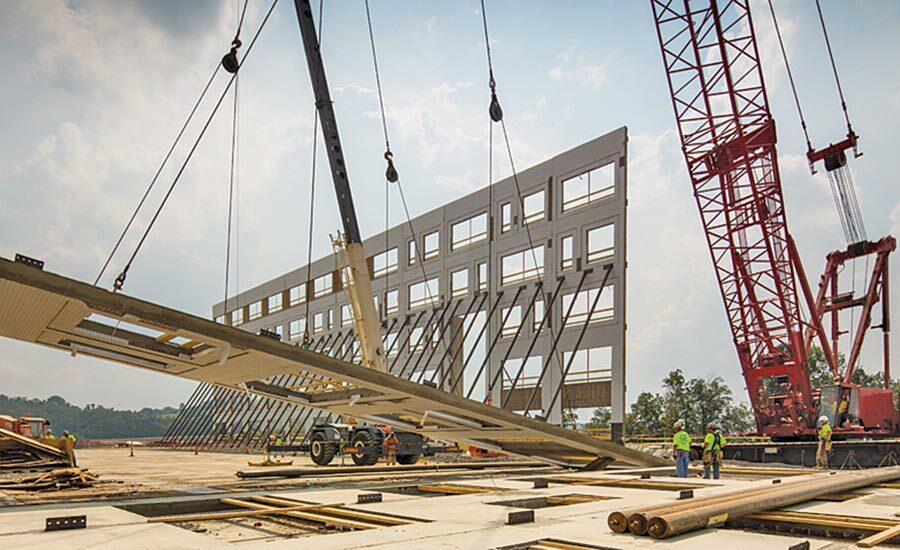Tilt-up wall construction has been around for quite some time and remains one of the most recommended construction methods for commercial buildings. Approximately 15 percent of all industrial buildings within the U.S. have been erected using tilt-up walls, with these buildings all being constructed for various uses and in various sizes.
There are many reasons why tilt-up walls are such a popular construction method for large commercial buildings, but this technique also has a couple pitfalls as well.
Advantages of Tilt-Up Walls
For the most part, tilt-up walls offer far more benefits than traditional or alternative construction methods. Here are four main advantages to go the route of tilt-up:
More Cost Effective than Cast-In Walls
Much of the expense in building normal cast-in walls involve how many crewmembers are needed for safe installation as well as additional equipment needs like scaffolding. Tilt-up walls require less equipment and a smaller workforce. Though the use of a crane is pricey, this method is still far more budget-friendly overall, especially for very large buildings.
Faster and Safer to Install
Though the casting process of the panels takes time, the overall process of installing tilt-up walls is one of the fastest. Once the panels are ready, it’s only a matter of using a crane to tilt them up for installation. While panels are being cast, crews that may be performing other worksite procedures can still get their work done as well. This increases worker safety and reduces worksite congestion when multiple contractors are working on a project.
Less Waste and Lowered Environmental Impact
Tilt-up wall construction means less waste overall compared to traditional cast-in walls. Cast-in walls require rebar, forms and other materials for the casting process, not to mention that typically more concrete is used as well. Tilt-up walls have much less waste to dispose of, which means less dangerous worksite clutter and a reduced impact on the environment. Tilt-up walls can also be recycled if the building is taken down, which further provides less environmental damage.
Allows for Some Customization and Architectural Design
The typical building being constructed with tilt-up walls doesn’t have to be left looking like bare concrete. In fact, some different textures and surface effects can be done to tilt-up walls during the casting process for a more decorative look. Money can also be saved as it may reduce the need for painting or other architectural design. That being said, tilt-up walls can be covered with essentially any type of siding. Wood exterior siding works very well and can completely transform the appearance of an otherwise very industrial looking building.
Disadvantages of Tilt-Up Walls
Though tilt-up walls are likely a good choice for the average commercial or industrial building, there are a couple possible downsides to consider before settling on this method. Here are the three main reasons tilt-up walls may be an inadequate choice.
Not Ideal for Complex Buildings
Generally a building being used for commercial or industrial uses isn’t going to be very complex, which is why tilt-up walls work so well. This method is perfect for large, rectangular buildings or structures. This means that architects looking into tilt-up walls may find it isn’t worth the trouble or even versatile enough for more complex designs. If you want a beautiful building that doesn’t just resemble a warehouse, tilt-up walls may not be the best choice.
Difficult to Work With on Some Worksites
A big difference between tilt-up and precast walls is that tilt-up walls are fabricated right on the worksite. While this an advantage to this construction technique it also limits how well it will work depending on worksite restrictions. Cast panels on-site means the worksite will need to be fairly flat and spacious. It is possible to cast panels on a flat surface nearby the worksite and those panels can be moved with the crane, but this isn’t ideal and may result in having to stack panels during the casting process.
Lacking in Versatility
Though tilt-up walls are somewhat versatile when it comes to large buildings, they aren’t the best idea for smaller projects. Typically using tilt-up is only good for a minimum size of about 5,000 square feet. A more versatile alternative would be using insulated concrete forms. This type of wall system is just as easy to install, but far more suitable for smaller commercial building projects.
Overall, tilt-up walls are an ideal construction technique. The ease and speed of construction, cost savings and the natural durability of the finished building is difficult to find any issue with. As long as the worksite is fairly flat and the building is going to be close to a traditional expansive rectangular building, going with tilt-up walls is an excellent choice.









Report Abusive Comment